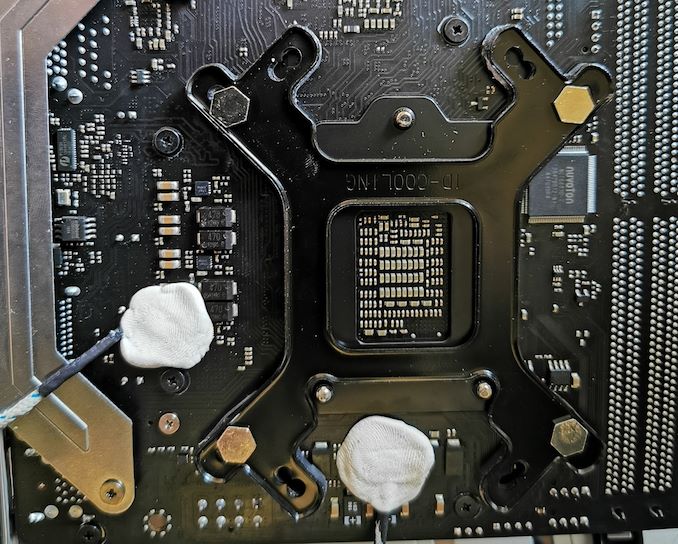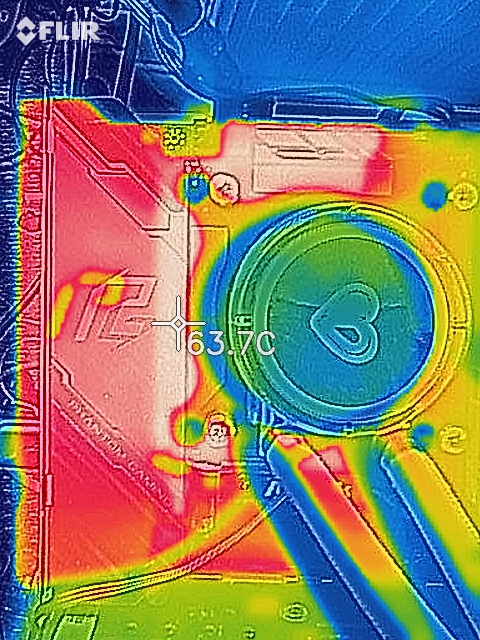AMD + ITX + TB3? It's the ASRock X570 Phantom Gaming-ITX/TB3 Motherboard Review
by Gavin Bonshor on October 9, 2019 12:00 PM ESTPower Delivery Thermal Analysis
One of the most requested elements of our motherboard reviews revolves around the power delivery and its componentry. Aside from the quality of the components and its capability for overclocking to push out higher clock speeds, which in turn improves performance, it is the thermal capability of the cooling solutions implemented by manufacturers that can have the biggest effect. While most solutions are almost always fine for users running processors at default settings, those looking to squeeze out extra performance from the CPU via overclocking put extra pressure on the power delivery. This is why more premium models often include heatsinks on its models with better cooling designs, heftier chunks of metal, and in some cases, even with water blocks such as the ASUS ROG Crosshair VIII Formula.

Two K-Type Thermal Probes attached to the rear of the power delivery on the ASRock X570 Phantom Gaming-ITX/TB3
Testing Methodology
Out method of testing out if the power delivery and its heatsink are effective at dissipating heat, is by running an intensely heavy CPU workload for a prolonged method of time. We apply an overclock which is deemed safe and at the maximum that the silicon on our AMD Ryzen 7 3700X processor allows. We then run the Prime95 with AVX2 enabled under a torture test for an hour at the maximum stable overclock we can which puts insane pressure on the processor. We collect our data via three different methods which include the following:
- Taking a thermal image from a birds-eye view after an hour with a Flir Pro thermal imaging camera
- Securing two probes on to the rear of the PCB, right underneath CPU VCore section of the power delivery for better parity in case a probe reports a faulty reading
- Taking a reading of the VRM temperature from the sensor reading within the HWInfo monitoring application
The reason for using three different methods is that some sensors can read inaccurate temperatures, which can give very erratic results for users looking to gauge whether an overclock is too much pressure for the power delivery handle. With using a probe on the rear, it can also show the efficiency of the power stages and heatsinks as a wide margin between the probe and sensor temperature can show that the heatsink is dissipating heat and that the design is working, or that the internal sensor is massively wrong. To ensure our probe was accurate before testing, I binned 10 and selected the most accurate (within 1c of the actual temperature) for better parity in our testing.
For thermal image, we use a Flir One camera as it gives a good indication of where the heat is generated around the socket area, as some designs use different configurations and an evenly spread power delivery with good components will usually generate less heat. Manufacturers who use inefficient heatsinks and cheap out on power delivery components should run hotter than those who have invested. Of course, a $700 flagship motherboard is likely to outperform a cheaper $100 model under the same testing conditions, but it is still worth testing to see which vendors are doing things correctly.
Thermal Analysis Results

We measured 63.7°C on the hottest part of the board during our testing
The ASRock X570 Phantom Gaming-ITX/TB3 uses a 10-phase power delivery which is running in a 4+2 configuration. The CPU section consists of eight ISL99227 60 A power stages which are paired up with four ISL6617A doublers, while the SoC section consists of two ISL99227 60 A power stages. Controlling the power delivery is a Renesas ISL69147 PWM controller. The cooling solution on the ASRock X570 Phantom Gaming-ITX/TB3 consists of two individual heatsinks; one aluminium heatsink which is a combined piece with the rear panel cover, and a separate SoC section which also cools two of the power stages of the CPU section. It's actually a really nice design as the aluminium rear panel cover is quite beefy and will benefit from cases with good passive airflow. -
Looking at our power delivery thermal testing results, the ASRock X570 Phantom Gaming-ITX/TB3 performs pretty well considering it's using a 10-phase design on such a small mini-ITX sized PCB. There are increased thermal properties to consider when running a high-powered mini-ITX system as condensed componentry tends to generate a little bit more heat than a sparser ATX PCB would. With 1.475 V set on the CPU VCore and the CPU Core Frequency set to 4.1 GHz, our temperatures maxed out at 64°C on ASRock's integrated VRM temperature sensor. Our probe on the rear measured 61°C, with our thermal imaging shot measuring 63.7°C on the hottest part of the power delivery. This is a good result for ASRock and although it doesn't quite have the cooling capabilities as some of the flagship models we have tested so far, for a $240 model with so much power and features on a mini-ITX sized model, temperatures in our testing we're absolutely fine. A processor such as the Ryzen 9 3950X with 16-cores is likely to stress the power delivery more than our Ryzen 7 3700X, but it's not likely to push the VRM temperatures into dangerous waters.











64 Comments
View All Comments
drexnx - Wednesday, October 9, 2019 - link
even before I knew it was a blink 182 reference, I still read it as "all the...small things"Tuxie - Wednesday, October 9, 2019 - link
I'm still waiting for a Mini-ITX board with AM4, 2x M.2 and 10GbE. No need for WiFi, SATA, TB or onboard DP/HDMI.jeremyshaw - Wednesday, October 9, 2019 - link
The last part is what kills this board for me. It wastes space on DP and HDMI (technically, just HDMI, since the DP is an input for the TB3), when it already has a TB3/USB-C connection to handle video output. If someone insists on using a $220 board for a 3400G (and I am being extremely generous here), let them fall on their own sword. Let them spend the extra $20-30 on a DP-->HDMI adapter. Don't waste precious space on this board with a HDMI connector.Even worse, the Intel version of this board has all of the same outputs, PLUS two more USB ports and another M.2 slot. So no matter how I slice it, this board is down on features vs existing ASRock boards. From what I understand, ASRock didn't link the M.2 slot to the extra 4 PCIe lanes from the CPU, either, so it's sharing bandwidth from the chipset (with LAN & TB3), just like the Intel board. What a waste.
umano - Friday, October 11, 2019 - link
I totally agree, let's hope in the futureFiveOhFour - Saturday, January 11, 2020 - link
i agree but the hdmi part isn't fair it makes sense given how common this form factor is for use as a home theatre pcFiveOhFour - Saturday, January 11, 2020 - link
thats a major dissapointment though for sure, so whats the best option for x570 boards with thunderbolt, aside from the $1,000 white one. I don't need a certain form factor, though it would've been nice, just the best/most features and quality and priceValantar - Wednesday, October 9, 2019 - link
They're not going to make a premium ITX board without WiFi - too risky in terms of lost sales. A lot of SFF PC users move their PCs around, and not all places have Ethernet available. Also, ditching SATA seems early - people have legacy devices still (though cutting it down to 2 SATA probably wouldn't be a deal breaker for many). Likely all of this could be fit on board if they went with some sort of stacked m.2 layout like the Gigabyte or the Strix.Beyond that, I agree on faster networking though. Even one of those Realtek 2.5GB controllers would be a huge (well, 2.5x) improvement. Fitting a 10GbE controller might be too tight of a fit, sadly. But maybe on a daughterboard/some sort of vertical m.2 board like WiFi controllers?
DanNeely - Wednesday, October 9, 2019 - link
I doubt we'll see many 2 sata boards anytime soon; but the total is dropping and starting to shift downward. Looking at newegg listings, and limiting AMD to x70 boards since the remainder of the 5xx series isn't out yet:x370 3x 4 ports, 29x 6 ports, 76x 8 ports, 2x 10 ports.
x470 21x 4 ports, 147x 6 ports, 19x 8 ports
x570 36x 4 ports, 181x 6 ports, 83x 8 ports.
10 ports has disappeared as an option. 4 ports has grown from 3 to 11% of the total, and despite bouncing back a bit this year 8 port models are a minority of designs now vs the default in x370 boards.
On the intel side, and sticking to Z series boards to stay with the same general market segment as AMD:
Z170: 3x 2 port boards, 20x 4 port, 68x 6 ports, 8x 8 ports.
Z270: 9x 4 port, 74x 6 port, 19x 8 ports.
Z370: 43x 4 port, 129x 6 port, 1x 8 port
Z390: 66x 4 port, 476x 6 port, 18x 8 port.
Similar trends overall; 8 port is much less common on Intel boards because their consumer chipsets only have 6 sata ports available; 8+ requires a 3rd party controller and has been much less common for years as a result.
With both brands I suspect the transition will be slow because consumer boards suffer from feature checkboxitis and the connectors are cheap. Reducing support on the chipset would push things faster but sata controllers are relatively small/cheap compared to top of the line USB/PCIe ones and both companies are doing variations of the flexible IO port thing so it doesn't cost them much either. It'll happen eventually, but I don't expect to see much movement until the price/GB gap narrows at lot between SSD and HDDs because of people wanting to make DIY NAS/Storage servers.
Heavenly71 - Wednesday, October 9, 2019 - link
Sadly this board severly lacks USB ports. And it also doesn't have an internal header for front panel USB-C.imaheadcase - Wednesday, October 9, 2019 - link
That isn't really a issue considering all the options you can add usb to a system now-a-days.